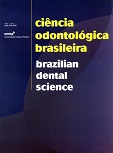Utilização de localizadores eletrônicos foraminais na determinação da odontometria, em dentes decíduos
DOI:
https://doi.org/10.14295/bds.2009.v12i2.355Abstract
A determinação do comprimento real de trabalho é uma etapa fundamental para o sucesso clínico, radiográfico e histológico do tratamento endodôntico, principalmente na dentição decídua, com o objetivo de minimizar injúrias periapicais e evitar alterações no germe dos dentes permanentes sucessores. O exame radiográfico é empregado na prática clínica para realização da odontometria, porém a determinação precisa do comprimento do canal radicular é dificultada devido a variações anatômicas, sobreposição de estruturas, distorções, erros técnicos ou erros na projeção. Os localizadores eletrônicos foraminais vêm sendo amplamente utilizados para a realização da odontometria em dentes permanentes, como precisão superior a 90%. Nos últimos anos, esses aparelhos têm sido indicados, também, para dentes decíduos, reduzindo a exposição do paciente infantil à radiação e o tempo de trabalho clínico. O objetivo do presente trabalho será apresentar a indicação, vantagens e eficácia do método eletrônico para odontometria, bem como sua técnica de uso e resultados obtidos na odontometria de dentes decíduos.
Downloads
Downloads
Published
How to Cite
Issue
Section
License
Brazilian Dental Science uses the Creative Commons (CC-BY 4.0) license, thus preserving the integrity of articles in an open access environment. The journal allows the author to retain publishing rights without restrictions.
=================




























